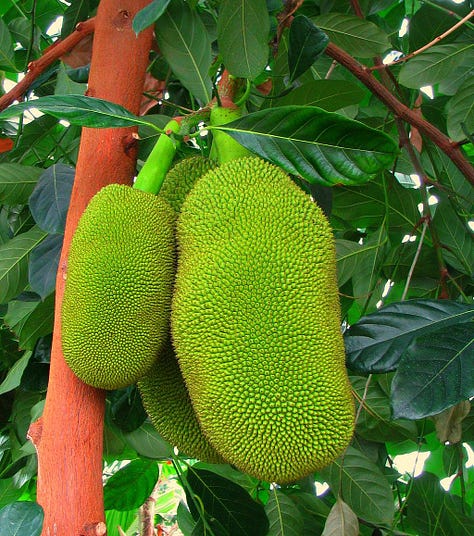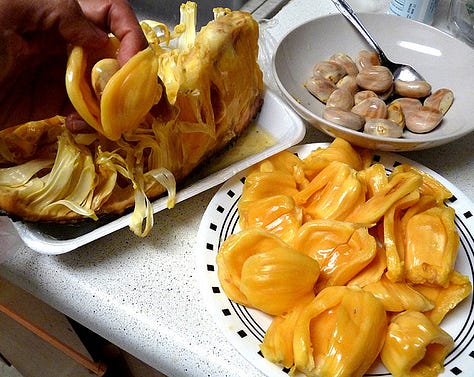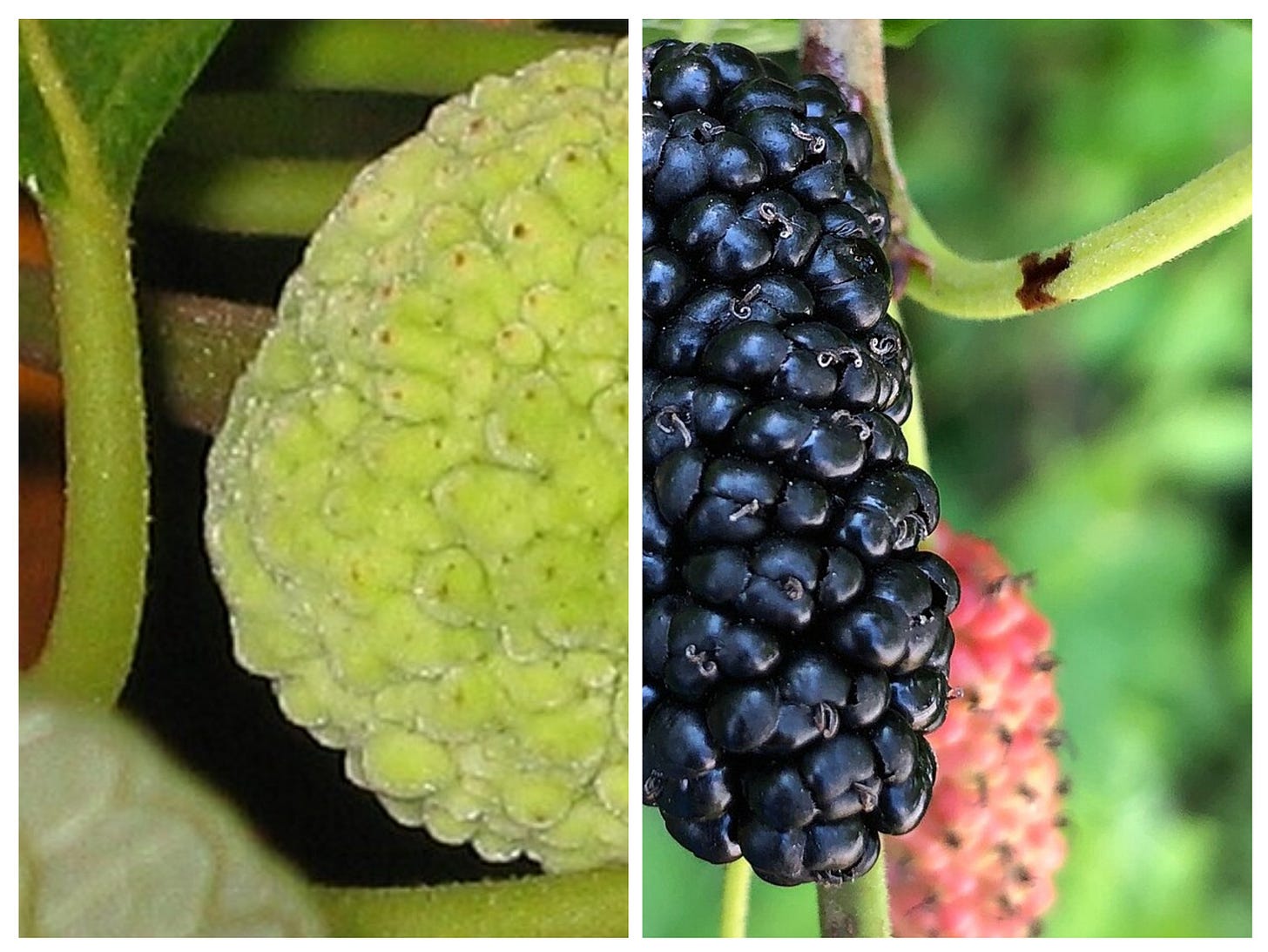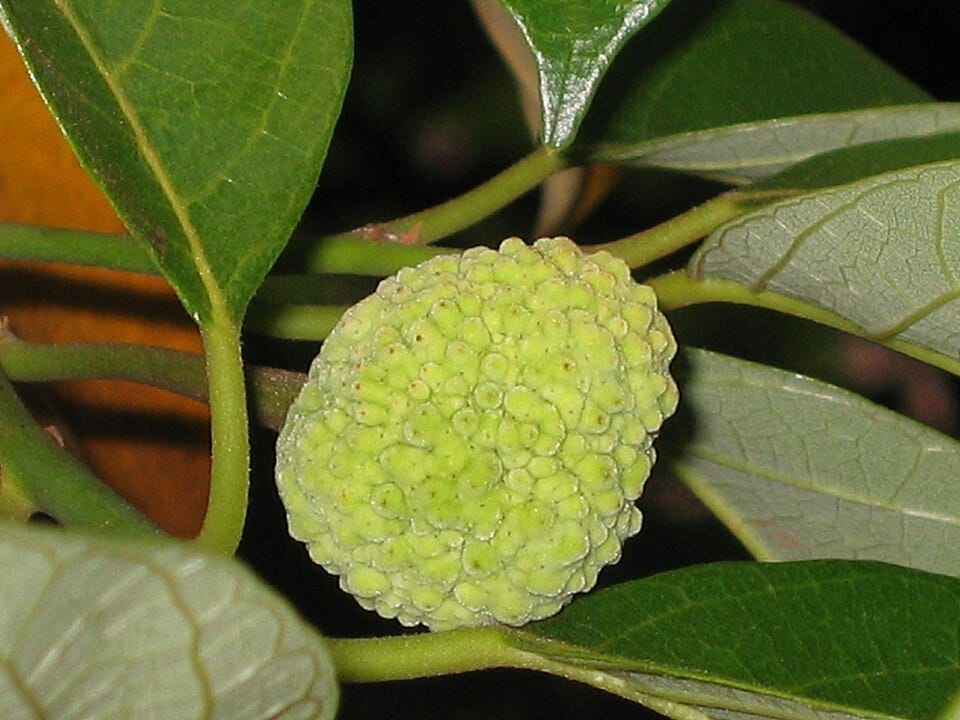A handy index to my “Franken-fruit” series.
Following on from my previous thought experiment about cold temperate perennial tomatoes, I decided to start a Substack series on other plants that could benefit from a similar treatment.
Perennial Cold Temperate Tomatoes
Every so often, I pick up the idea of perennial cold temperate tomatoes and toy with it before dropping it again. It’s like an itch in my brain that won’t go away.
I'm the first to admit that I'm jealous of the vast array of edible plants that can grow in hot or tropical climates. Say what you want but there's really no substitute for a large amount of sunlight and a warm air temperature. I can pick the warmest spot in my garden and shelter my plants as much as I can but it will never be as productive as a tropical food forest. Plants never really stop growing in these warm tropical places.
So this series comes from a place of jealousy, maybe, but I hope that we can still reap a fruitful bounty from these ideas
So what are we really looking for? What type of plant is worth this effort? For me, I would like to bring the everyday person the same sense of wonder that I first experienced when I stood in the middle of an Asian fruit market.
I’m hoping to bring more rigour to this series than to point at a tropical fruit and wish for a cold hardy variant. There is plenty of research to be done, but at the end of the day, there is an element of the so-called moon-shot thinking. Anyway, why not? I’m recovering from surgery and I have the time to spare (for once).
Jackfruit
I was very inspired recently by a podcast interview that my friend and fellow Substack author, Shane Simonsen, recorded with David B Lauterwasser (another substack author). They talked about David’s tropical food forest in Thailand, and I was particularly struck by Jackfruit. Artocarpus heterophyllus; a seemingly perfect crop; bearing year round in his climate. The gigantic fruit (55kg!), seed and young leaves are edible (and tasty). It wouldn’t take much additional effort to bootstrap a Jackfruit dish to a nutritionally complete meal! Nearly every part of the tree has useful properties.



Let’s go over the technique I first outlined in my perennial cold temperate tomato article.
Graft a tomato plant to a cold hardy root stock in the same family (Solanaceae), like a goji berry tree
Harvest the fruit from the grafted tomato
Grow some fruit from this grafted tomato
Regraft this next set of tomatoes to the goji tree
Repeat steps 1 to 4 multiple times
The idea is that a small percentage of genetic material from the rootstock will migrate into the seeds of the tomato every time we perform this cycle, leading to a Franken-tomato plant with the cold tolerance of a goji berry tree.
We want to repeat this for Jackfruit which is in the Moraceae family, but there are a few blockers that require some thought.
The reason why I believe this process is plausible for tomatoes is that the graft has been documented between it and a goji berry tree.
Since writing that article I’ve been talking to several people who are more knowledgeable than me. It turns out that there is a whole body of active research and patents(!) out there for this type of gene transfer.. There’s enough for a whole Substack article, which I’ll likely write in due course.
Anyway, the relevant detail for me is that tomatoes - which are perennial in suitable climates - can at least perform annually in my cold temperate climate. That is, they grow from seeds, bear fruit containing genetic material in one year and then die off (it’s a bit like plant torture if you squint).
Furthermore, a goji tree can bear fruit in my cold temperate climate too.
All this to say, 1) the scion should at least be borderline able to bear fruit in the target climate, and 2) that the rootstock and scion should probably be similar enough in character that they can grow in harmony. I think there would be a lot of manual intervention if this were not the case.
For the case where the rootstock is a lot more vigorous than the scion, you’d need to be handy with shears. This happened to me when I tried to graft a bramley apple seedling scion to a vigorous Siberian Crab Apple tree (Malus bacatta). The Siberian rootstock kept trying to leaf out under the graft, even sending out a sucker. At least in this type of asymmetry we can be sure there’s a more than adequate supply of phloem, xylem and other organic substances into the scion.
Grafting a Jackfruit to a cold temperate rootstock would fall into the other end of the spectrum. My guess is that it would stress the rootstock immensely to supply the full growing demands of the scion. In their native lands, Jackfruit trees easily reach 9m with trunks at 30cm diameter. At their maximum, they can approach 21m, with 80cm trunks.
It would be like grafting an elephant head to a deer’s body.
We’re further stymied because Jackfruit trees take at least 4 years to bear fruit in ideal conditions, so we’re stuck with performing this graft and grow cycle in a large heated greenhouse. We’d probably need more light energy than cloudy Britain can naturally supply so we’d need artificial lights in the winter. Fruit that big ultimately needs lots of energy input, there’s no way around it.
So we have a pretty miserable picture now. A large, heated and artificially lit green house with a piddly Moraceae rootstock that’s being sapped of life by a Jackfruit scion. What a sight that would be. Whoever tries this would need lots of money and time.
Can we do any better?
For Jackfruit (Artocarpus heterophyllus), I don’t think so. The gulf is just so large, even though they can technically survive light frosts, overcoming that would land you smack bang into insufficient light conditions (overcast British skies) and warmth to bring those gigantic fruit into maturity.
Pull a breadfruit out of a hat
Luckily, there are many edible members of the Artocarpus family. It isn’t called the breadfruit family for nothing. The Greek word “arto” literally means “bread”, and similarly “karpos” means “fruit”.
Let’s find the cold hardiest, most shade tolerant and least vigorous Artocarpus species we can. Why “least”? Because they’re all tropical species and grow prolifically; it’s better to manage the genetic expectations as much as we can from the outset. We want one that matches the target environment (cold temperate) as much as we can. Shade tolerance should be obvious; a bright day in Britain is like a candle in the tropical night.
If we’re going to sow an elephant head to a deer’s body, we need the smallest, meekest Elephantidae we can find (though in the case of the Elephantidae, we’d need to invent time travel as the only two non-extinct species are huge).
There are currently 73 recognised species of Artocarpus. Wikipedia lists 10 that are actively consumed but there are sure to be more. The question now becomes; how do we find the species in this 70-odd collection that satisfies our criteria? Practically speaking, once we find it how do we source it back to our cold temperate climate for our Franken plant experiments?
In my searches, I found a wonderful forum called the Tropical Plant Forum. Within this forum, I found a group of people talking about “pushing the zone” on Artocarpus: music to my ears. Someone in that thread zooms in on a species called “kwai muk”, which he appears to take from something called the “CRFG Cultural Data sheet”. Going back to the original source, CRFG are the California Rare Fruit Growers; quite an incredible non-profit organisation that exists for the purpose of “pushing the limits and the range of fruit growing world wide”. It looks like we’ve hit the jackpot as they’ve got a prepared list of exotic fruits and their “harm” and “kill” temperatures. We see that “kwai muk” is Artocarpus hypargyraeus and will suffer harm at -2.2C (28F) and death at -3.9C (25F). Incidentally, plain Jackfruit is no slouch, surviving death at above -3.3C (26F). Not bad for a couple of tropical plants, though air temperature isn’t everything!
In couldn’t find any Creative Commons licensed images of the inside of kwai muk, but this post should enlighten you on size too.
In terms of edibility, my research has thrown up mostly anecdotal information but there have been no red flags. One page from the Archives of the Rare Fruit Council of Australia has some fairly positive things to say:
The fruit must be completely ripe for fresh consumption; unripe fruit exudes a white, sticky latex when the skin is broken. The ripe fruit has an excellent flavor and is good for fresh consumption in the local production area. The fruit has best quality when ripened on the tree, but it also can be harvested in the mature green stage and ripened at room temperature. Mature-green fruit ripens in 1-3 day, so shipping would be difficult. No experiments have been reported on storage of this fruit.
The fruit can be preserved with salt, with sugar syrup or by drying. The dried fruit has a good texture and flavor (B.A. Campbell, Homestead, personal communication).
The same page also describes kwai-muk as slow growing. I’ll take two out of three.
So we’ve found the smallest elephant head, let’s find the most vigorous deer to sow it onto.
There’s Moraceae Choice
Terrible puns aside, there’s an embarrassment of riches in the Moraceae family. I even knew of two off the top of my head: mulberry (Morus) and fig (Ficus). In fact, this is also known as the mulberry or fig family. Of the two, mulberry is hardier and has a less unusual fruiting mechanism. They’re both easy to source, so mulberry is the logical choice.
In the mulberry genus, there are three widely known species: Morus alba, M. nigra and M. rubra (white, black and red). White mulberry is by far the hardiest: allegedly roughing it down to -31.7C (-25F)!
Less deer, more like deer god.
So there we have it, grafting a kwai-muk (Artocarpus hypargyraeus) scion to a white mulberry tree (Morus alba), maybe inside an unheated greenhouse for the first few years. Cross your fingers for fruit and plant out the seeds for multiple re-graft cycles. Cross even more fingers that the later generations take on the hardiness of mulberries. Spread the seed and word wide and far at what you’ve achieved.

Final Thoughts
Since I wrote the post on cold temperate perennial tomatoes, I’ve met some extremely knowledgeable people who’ve taught me a lot about my proposal. I feel very much a disciple to their mastery, but I’ll endeavour to impart what I know in easily digestible forms in later posts. If you want a sneak peek into this, look at the world of mentor grafting.
I will also say, though, that there appears to be some discussion on A. hypargyraeus and its miss-classification as A. parvus. I dug into this topic lightly but just got increasingly confused.
Some might ask: why we don’t just cross pollinate something in the Artocarpus family with Morus alba? I would reply: sure, why not? I just view this mentor grafting technique as another tool in the plant domestication arsenal. There are pros and cons to both techniques that I won’t go into right now.
What are some famous tropical fruits that would blow your mind if you found them growing vigorously in a cold temperate climate? Leave a comment below and it might feature in an upcoming article!
Until next time.







My guess for the best path forward would be multispecies hybridisation with Artocarpus (performed in a subtropical or tropical area) then growing bulk seedlings in ever colder climates. Cold tolerance is a multi-gene trait, so the chance of it being transferred by mentor grafting is low (unless it is imparted by a microbial endosymbiont perhaps?).
As a comparable historic example- until relatively recently Quercus were a tropical genus (the centre of diversity is in Mexico to this day). One time when the ice sheets retreated a group of them developed cold tolerance and headed north as a swarm of repeatedly hybridising species.
Nice! Fun stuff to think about. One obvious fruit that would be great to grow in the cool temperate climate would be mango. But my partner also loves mangosteen, so that would also be added on the list. But I'm sure there are also many awesome fruits that we just have little knowledge of because they don't transport/store well.